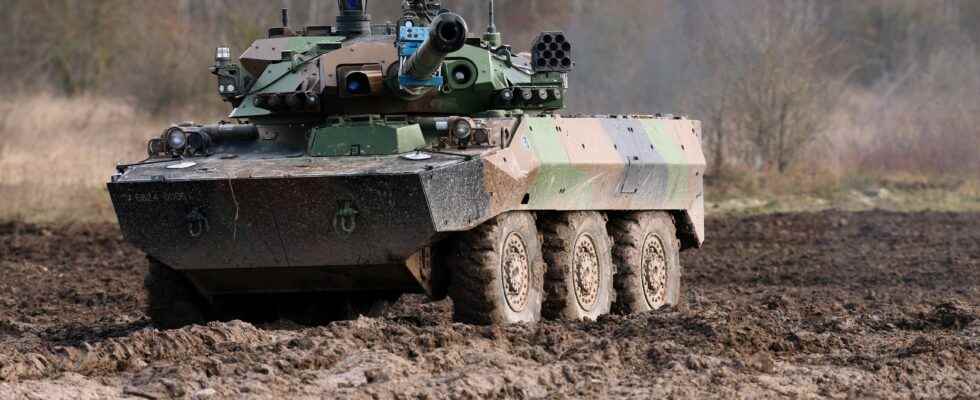He fought in the Gulf War, then in Afghanistan, before participating in anti-jihadist operations in the Sahel. The AMX-10 RC will soon discover a new military theatre, Ukraine. France announced on Wednesday January 4 that it was going to supply this armored vehicle on wheels, equipped with a 105 mm gun, to kyiv, pushing its military support a little further after sending Caesar guns, Crotale anti-aircraft systems, VAB troop carriers and LRU rocket launchers.
How much will be taken from the 248 copies currently available to the army? The number remains to be determined, as well as the necessary training time for Ukrainian crews and the rate of deliveries – all crucial points. This announcement by the Elysée is nonetheless a turning point in the highly political issue of the supply of armaments to Ukraine. Until now, its European allies had only supplied it with Soviet-designed tanks, a legacy from the Cold War era.
Is the AMX-10 RC a tank? “While its firepower allows it to deal with well-protected targets, its protection is insufficient and limits its use to armed reconnaissance and flank protection”, recalls Léo Péria-Peigné, weapons and prospective researcher at the French Institute of International Relations. Thus, it is not a “heavy tank” like the Leclerc, which weighs 55 tons (three times more than the AMX-10 RC), is tracked and fires 120 mm shells.
President Emmanuel Macron and his Ukrainian counterpart Volodymyr Zelensky nevertheless present it as a “light combat tank”. This denomination is not neutral, since it makes it possible to present France as the first supplier of “tanks” of Western invoice to Ukraine since the beginning of the Russian invasion, on February 24. It also makes it possible to cut short criticism of the sometimes ambiguous position of the French head of state, who had called for “not to humiliate Russia” and to give it “security guarantees”.
Above all, this announcement forced Germany to position itself on the subject. For several months now, kyiv has been insisting that it deliver Leopard 1 or Leopard 2 tanks (cousins of the Leclerc and the American Abrams), which many European nations also have, some of which are determined to supply them to the Ukrainian army. . So far, Berlin has claimed that it will not donate “non-Soviet” tanks, because no other country, starting with the United States, has decided to do so. Berlin, however, announced on Thursday, January 5 that Germany and the United States planned to take a “new qualitative step” in arms deliveries to Ukraine. It was not specified which weapons it would be but according to several media, including the daily Suddeutsche ZeitungBerlin intends to deliver armored infantry fighting vehicles of the “Marder” type.
Pressure on Germany
“The French precedent will weigh in the debate in Germany, where political divisions and tensions are strong on the subject, because the classic tank continues to evoke in the minds the panzers of the Second World War”, underlines François Heisbourg, special adviser to the Foundation for Strategic Research. Chancellor Olaf Scholz and his party, the SPD, are opposed to Leopard deliveries, unlike the Liberals and Greens, his coalition government partners.
The reactions were not long in coming. “Once again, France is taking on the role that was expected of Germany and is taking the lead itself,” lamented the chairman of the Defense Committee at the Bundestag, Marie-Agnes Strack-Zimmermann. Ukraine must “win to also defend our freedom and our values - and this can only be done with the support of the tanks”, added this executive of the liberal party.
The pressure could increase further if Washington gives the green light to the delivery of M2 Bradley infantry vehicles. The US Army has a considerable stock of these light tracked armored vehicles. Capable of carrying six infantrymen in addition to its three crew members, they are armed with a 25 mm cannon and, above all, anti-tank missiles. Sending to Ukraine could be all the faster since a number of these devices are stored in American bases in Germany. The United States has already planned to retire them from service in the 2030s, which makes the idea of a transfer easier.
Same logic for the French AMX-10 RCs, which have begun to be replaced by Jaguars, new generation 25-ton reconnaissance and combat armored vehicles, and will all be so by 2027. A priori, delivery to the Ukraine of the AMX-10 RC, unlike that of the Caesars, should therefore have no effect on the combat capabilities of the French army.
